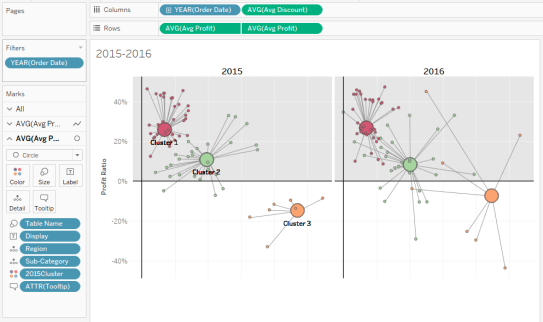Requirements
- THIS IS A SINGLE SHEET. This is not using the 3 sheets in a container technique
- The first Level is Year, the Second Month and the Third is Day
- You drill into whatever you click. If you click on 2015 at the Year Level, you will see all 12 months for 2015
- Users can control->drag to select multiple years/months and Tableau will drill down with all selected.
- When a user clicks on a Day at the Third Level, the viz resets back to all Years
- The Sub Header will let the user know the date range in the viz.
Data for the workout can be downloaded from here
Here is my output for the challenge (Click on Image for interactive version):
Lets go through step by step process of re-creating this dashboard and also understanding how easy it can be to implement this feature into your dashboard and make dashboard interactive without adding any new sheets.
Step 1: Import the superstore data into Tableau then drag orders sheet 3 times into data area and you should be able to see something like this:

For this dashboard requirement we need 3 fields i.e. Table Name, order date and sales so we will remove all other fields and go to Sheet 1
Step 2: Before we start the visualisation, we will create all required calculated fields to ensure we have all the fields ready to use:
DrillLevel: Add identifier for Orders union

Year_Month_date: Calculated field to show data Year and monthly format and will be used for BAR chart for Year and Monthly data

Day_date: Calculated field to show day and will be used for LINE chart to show daily data for the month

BarSize: Size of BAR in the sheet

Drill down filters for current and previous level filters:
CurrentLevelFilter:

PreviousLevelFilter:

Step 3: We are ready to start with visualisation now, lets drag Year_month_date and Day_date into rows and sales into columns

Change both date fields into exact date:

For Year_Month_date, select the chart type as Bar chart and line chart for day_date field then convert day_date into dual axis with sync axis. Remove the color tags from both the axis to main blue shade for charts


Drag PreviousLevelFilter into details section under marks area:

Drag Bar Size into Size area for bar chart (Year_Month_date) and have measure value as minimum:

Step 4: Create a Dashboard and drag sheet 1 into Dashboard

Then go to Dashboard –> Action –> add Filter –> set the filter source field as PreviousLevelfilter and Target field as CurrentLevelFilter as shown below:

That’s it our Drilldown report with single sheet is ready. We will need to format and clean the report to make it look like above final report.
You can download the Tableau file from here
Happy Data Visualisation!!!!
Thanks for visiting this post. Please do let me know your feedback and if any particular topic you would like me to write on.
Do subscribe to Tabvizexplorer.com to keep receive regular updates.





















































